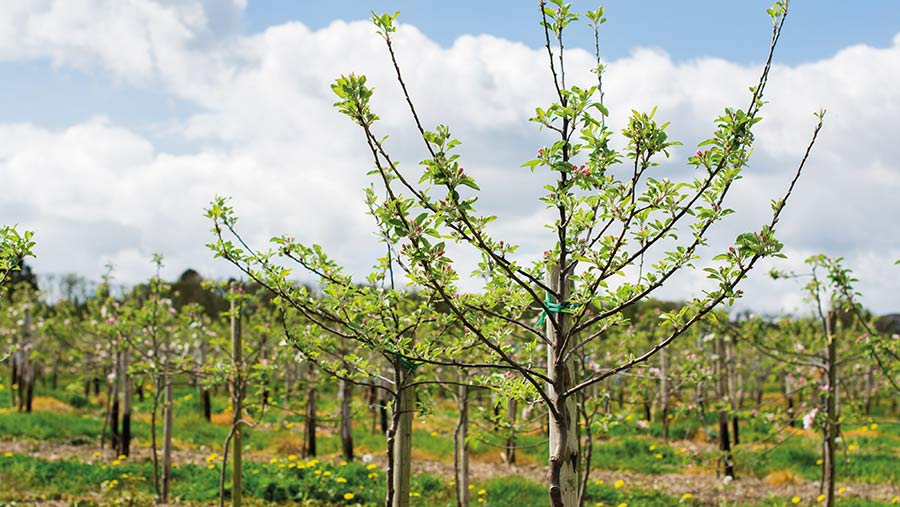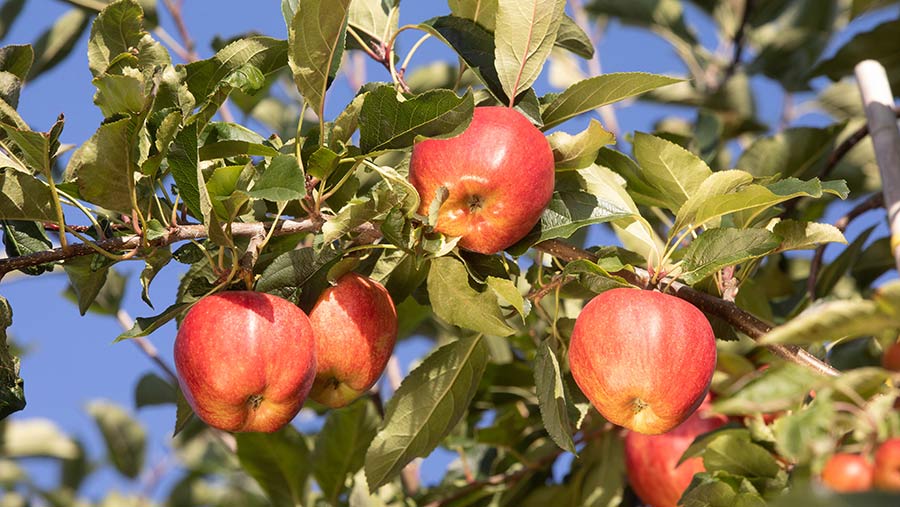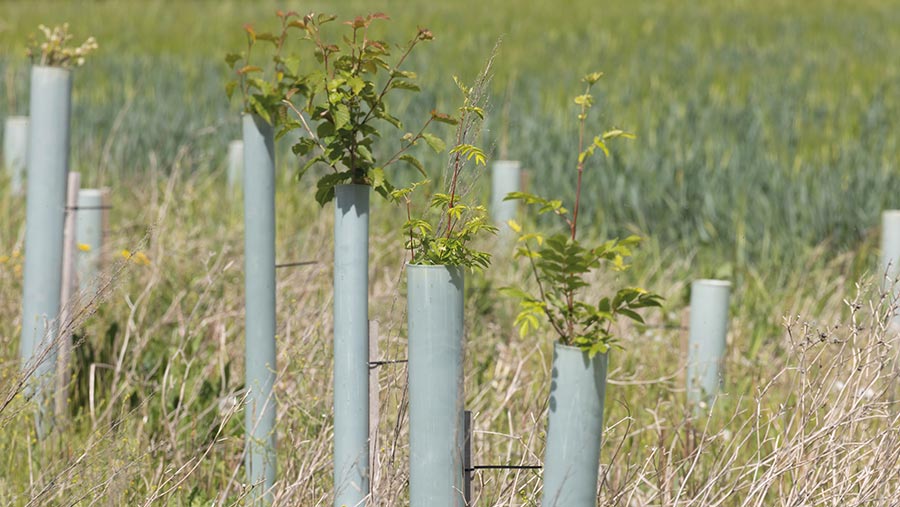The benefits of integrating trees into productive arable land
 © Liliya Trott/Adobe Stock
© Liliya Trott/Adobe Stock Trees can sometimes be viewed as an awkward obstacle in arable fields, but their strategic integration can help deliver multiple benefits to create productive farming systems.
Agroforestry combines trees and shrubs with agricultural crops or livestock. More precisely, silvoarable is the integration of trees within arable fields and, when designed correctly, can promote soil health and improve nutrient cycling.
Most importantly, planting trees does not have to involve taking productive arable land out of food production. Trees can grow in tandem with the farmed environment and act as an additional income or even food source.
See also: What to consider when increasing soil carbon stocks
Farming in 3D
Clive Thomas, senior adviser at the Soil Association, explains that agroforestry is an effective way of “farming in 3D” and can help improve overall farm resilience.
“With greater heights and depths above and below ground, trees bring the potential for maintained and enhanced food production, while delivering a range of environmental benefits,” he says.
We take a closer look at the benefits trees can bring to cropping systems.

© Tim Scrivener
1. Reduce erosion and boost soils
Erosion can reduce the long-term fertility of soils by removing nutrient-rich topsoil and organic matter.
About 2.2m tonnes of topsoil is eroded annually in the UK, where the sandy soils of eastern and central England are the most risk-prone.
“Trees act as an effective way to mitigate against soil erosion, as their deep-reaching roots bind soil together,” explains Mr Thomas.
This helps improve water infiltration rates and slow sediment flow, reducing soil and water movement and, consequently, run-off, which can otherwise have a knock-on effect on water quality.
Other key benefits are efficient nutrient cycling on farms and nutrient sinks to reduce leaching. “The deep roots of trees cycle nutrients and water from lower in the soil profile and bring them closer to the soil surface, where arable crops can access them,” he adds.
The addition of leaf litter and root debris also promotes soil structure and increases organic matter level.

© Tim Scrivener
2. Protect from weather extremes
Strategically planted strips of trees known as shelter belts can protect crops from weather extremes. This influences the crop microclimate by reducing wind speeds across an area of up to 30 times tree height.
Shelter provides an effective way to increase both air and soil temperature, which can contribute to an extended crop growing season, earlier germination and increased growth rates and quality.
In addition, these natural windbreaks can reduce lodging risk and subsequent yield losses. They even act as a natural barrier to prevent wind erosion and the spread of fungal diseases.
3. Efficient water management
“Trees improve soil infiltration and water retention by increasing the capacity of the land to retain water. This means they are an effective flood mitigation method,” says Mr Thomas.
They also play an important role in regulating crop water loss through a process called evapotranspiration. This is affected by sunlight, wind speed, temperature and humidity.
Lower wind speeds increase the level of humidity around the plant surface, which slows the rate of evapotranspiration and water loss from the crop. This, in turn, increases the rate of photosynthesis, as water is no longer a limiting factor.
Although trees compete for water and nutrients, and create shade, this tends to only affect crops 2-3m from the shelter belt. When designed strategically, there is an overall positive effect on water use efficiency, photosynthesis rates and subsequent crop yield for the protected area.
4. Greater productivity
Not only do trees shelter crops from the elements, Mr Thomas highlights how trees can provide additional income and alternative inputs to the farm business.
“Agroforestry is another way to diversify the farm income through the sale of fruits, nuts, timber and wood fuel. These products can even be used for off-farm sale or on-farm use.
“For example, mature trees could be used to make a farm’s own fencing equipment. Woodchip from hedges or pruning extracts could be used to create compost to increase soil organic matter, water-holding capacity and nutrient levels of soils.
“What’s more, by farming upwards in a more 3D manner, there is opportunity to increase land use efficiency and get more output from a given area of land,” he says.
5. Crop pollination and biodiversity
Trees play an important role in supporting biodiversity and provide habitats for an array of beneficial insects.
Woodland also provides the connectivity and food sources for wildlife, helping the movement of species around the farm, especially when patches of woodland or other habitats are linked.
In fact, trees and hedges act as “highways” for bees, hoverflies and other pollinators. Important services such as pollination and pest control can be improved in nearby fields and beyond.
Tree planting design advice from the Soil Association
Site selection for tree planting is largely determined by the end target and environmental factors.
To reduce soil erosion, target planting across the contour of fields or in areas vulnerable to runoff to provide the greatest practical benefit.
For shelter belts, the direction of wind, topography and farming practice should be considered. Effectiveness is influenced by tree height, length, orientation, width and permeability. Windbreaks sited at right angles to the wind give maximum protection.
- Height To maximise sheltered area, the windbreak should be as tall as possible, although the effects of crop shading should be considered. Fast-growing species such as poplar, alder or birch are popular
- Width It’s important to account for the permeability of trees when designing shelter belt width. Aim for a permeability of 40% to allow the wind to gently flow through the windbreak rather than forcing it upwards, which would create turbulence. Designing one or more lines of trees with different densities and species can help achieve this. The wider the windbreak, the less permeable it is.
- Length Generally, the length should be about 10-12 times the height of the shelter belt
Alleys
Agroforestry plantations can be based on alleys, which are equally spaced rows of trees planted in arable fields.
This creates the opportunity for dual cropping – such as wheat and apple trees – which is commonly seen across Europe.
To maintain productive arable cropping, the distance between tree rows should be more than the widest piece of farm machinery.
Uncultivated strips next to the trees should be at least 2m to avoid root damage from machinery. Within row, widths should be about 4-10m.
To increase light availability to the alley crop, tree rows in a north-south orientation tend to be more efficient than east-west.
Row orientation also affects wind speed. If the aim is to reduce soil erosion by wind, plant rows perpendicular to the prevailing wind.
It is important to avoid electricity lines and account for underground drain pipes, particularly when planting species such as a poplar and willow, which have vast root systems.
Source: Soil Association agroforestry handbook

